
Drawing by Matt Strieby [2016].

Forest of emergent P. montezumae above a P. hartwegii canopy near the divide on Mex-175 N of Ixtlan de Juarez, Oaxaca [C.J. Earle, 2005.02.08].
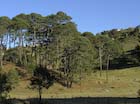
P. montezumae (mostly) forest near Campo Alegre, San Joaquin, Querétaro (about 20.9°N, 99.6°W) [C.J. Earle, 2007.02.16].

A 38.4 m tall tree [C.J. Earle, 2005.02.05].

A 150 cm DBH tree [C.J. Earle, 2005.02.05].
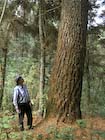
Me with a large tree on Nevado de Colima, Michoacán [C.J. Earle, 2005.02.05].
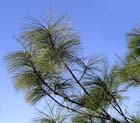
Foliar units [C.J. Earle, 2007.02.16].
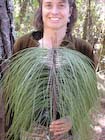
Bonnie with a branch bearing 35 cm long needles [C.J. Earle, 2005.02.08].

An actively growing shoot [C.J. Earle, 2003.04.27].
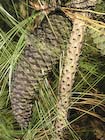
One-year-old cones in situ [C.J. Earle, 2005.02.11].
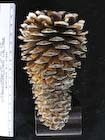
Mature cone, collected while still shedding seeds [C.J. Earle, 2005.02.10].

A seed [C.J. Earle, 2005.02.05].
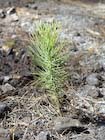
A seedling, about 10 cm tall [C.J. Earle, 2005.02.08].
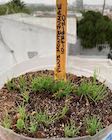
Recently germinated seedlings [Facebook post by Victor Hugo Garza Guajardo, 2020.03.15].

Pinus montezumae
Lambert 1832
Common names
Pino, ocote [Spanish]; Montezuma pine.
Taxonomic notes
Two varieties: Pinus montezumae Lamb. var. montezumae, and Pinus montezumae Lamb. var. gordoniana (Hartweg ex Gordon) Silba 1990. This species belongs to Pinus subsection Ponderosae; see the "Taxonomic notes" for Pinus ponderosa for discussion of relationships within the subsection.
Syn. for var. montezumae is legion, with dozens of synonyms authored by Roezl in two catalogs, 1857 and 1867. For the full listing, and the story of Roezl's enterprising approach to taxonomy, see Farjon and Styles (1997). Briefly, Roezl collected during a period when the horticulturalists of Europe were very keen on novelties and would pay well for them. In response, Roezl managed to find new Mexican pine species at every turn in the road, often naming his discoveries for prominent European nurserymen and estate owners. Roezl's work was generally validated by European taxonomists (particularly Carrière 1867) until Parlatore took the time to examine Roezl's collections; he promptly reduced them all to synonymy with seven previously-known species (Farjon and Styles 1997). You are unlikely to see this species referred to under any of Roezl's synonyms, except perhaps as an elderly tree in a private European collection. The following synonyms are more commonly encountered: P. occidentalis Kunth 1817 non Sw. 1788, P. russelliana Lindley 1839, P. montezumae Lamb. var. lindleyi Loudon 1842, P. pseudostrobus Gordon 1858 non Lindley 1839, P. montezumae Lamb. f. macrocarpa Martínez 1948, P. montezumae Lamb. var. mezambrana Carvajal 1986) (Farjon 1998). Much of this taxonomic confusion stems from the fact that var. montezumae is a highly polymorphic species, and in fact Farjon and Styles (1997) describe it as having continuously variable properties leading to P. devoniana.
Pinus montezumae var. gordoniana is also known as Pinus gordoniana Hartweg ex Gordon 1847, and may be returned to that status in these pages; it is not clear that it is more closely related to P. montezumae than to P. douglasiana or P. maximinoi.
Description
"The tree--This is a large, very fine pine, 20-35 m high and 50-80 cm in diameter; occasionally it may reach a height of 40 m and diameter of 1 m. The branches are large, mostly horizontal, forming a thick, rounded crown. Young trees have a dense pyramidal crown.
"Bark--On mature trees thick, dark grayish brown, divided by deep vertical and horizontal fissures into rough, scaly plates. In young trees the bark is reddish brown, rough and scaly.
"Branchlets--Thick, stiff, scaly and rough; reddish brown; bases of the leaf bracts are prominent and decurrent.
"Leaves--Mostly in fascicles of 5, occasionally 4 or 6, variable from thick and erect to slender and slightly drooping, 15-25 cm long, occasionally 30 cm; the margins finely serrate; stomata present on the dorsal and ventral surfaces; resin canals 2-6, usually 4 or 5, medial; exterior walls of the endoderm thickened, fibrovascular bundles 2, contiguous but distinct. Fascicle sheaths brown, about 15 mm long, persistent.
"Conelets--Ovoid-conical, the scales thick and bearing a small erect prickle, in groups of 2 or 3 on stiff, scaly, erect peduncles.
"Cones--like the leaves, cones are also variable, from long-ovoid to ovoid or conoid. They are usually slightly curved, 12-15 cm long and 7-10 cm wide when open. Light brown and often lustrous, they are borne in groups of 2 and 3 on short (about 10 mm), stout peduncles that remain attached to the branchlet with a few basal cone scales when the cone falls. The cones open at maturity (during the winter months) and are deciduous.
"Cone scales--Thick, hard, stiff, the apophyses raised to subpyramidal, transversely keeled; the umbo dorsal, slightly raised, grayish brown, bearing a small prickle that is usually deciduous.
"Seed--Small, dark brown, 6-7 mm long with an articulate seed wing about 20 mm long and 7 mm wide; cotyledons number 6, 7 and 8, mostly 6 and 7.
"Wood--Sapwood yellowish white, the heartwood light brown; hard, heavy and resinous; widely used for lumber and general construction" (Perry 1991).
Distribution and Ecology
Mexico: Nuevo León, Coahuila, Tamaulipas, Hidalgo, Tlaxcala, Puebla, Veracruz, Mexico, Morelos, Distrito Federal, Michoacán, Jalisco, Guerrero, Oaxaca and Chiapas; and Guatemala: departments of Huehuetenango, Quiché, San Marcos, Quezaltenango, Totonicapán, Sololá, Chimaltenango, Guatemala and Jalapa. This distribution places it in the mountains of the Great Cross Range, with extensions N along the Sierra Madre Oriental and S into Guatemala (Perry 1991). Hardy to Zone 9 (cold hardiness limit between -6.6°C and -1.1°C) (Bannister and Neuner 2001). See also Thompson et al. (1999).
Distribution data from USGS (1999). Points plotted as tree icons represent isolated or approximate locations.
"P. montezumae grows under a variety of conditions ranging from warm-temperate to cold-temperate and altitudes from 2,000 (rarely less) to 3,200 m. Rainfall over its range also varies from 800 to 1,000 mm or more annually. At the higher altitudes snow, sleet and frosts occur during the winter months, while most of the rain occurs during June-September... [T]he best trees grow on the high mesas and valleys of the Great Cross Range of mountains that extend across Mexico from Perote and Orizaba peak (Cerro Orizaba) on the east, to Toluca..., Morelia, Uruapan and into the forests of Michoácan westward toward Coalcomán. Very fine trees [grow] under similar conditions and elevations in Chiapas south of San Cristobal de las Casas and in Guatemala along the mountains eastward from San Marcos (15° N latitude) to Quezaltenango, Sololá, Chimaltenango and the town of San José Pinula. The species attains its best development on well-drained soils of the high mesas and lower slopes of the mountains. Although it also grows on dry to arid sites, under those conditions growth is slow and the trees are often low and very branchy" (Perry 1991).
Remarkable Specimens
When Bob Van Pelt and I were wandering through central Mexico in February 2005, the largest and tallest trees we found were in the forest E of Cortes Pass on the road to Puebla. The tallest tree was 38.4 m tall (laser measurement), and the largest was 150 cm DBH. The tall tree is shown at right. There is a record of a tree 51 m tall and 134 cm DBH at the Forest Research Institute in Rotorua, New Zealand (measured 2014; The New Zealand Tree Register).
The oldest known living specimen, 203 years, was documented in a tree-ring chronology covering the period 1772-1995 (fully crossdated), collected Reserva de la Biosfera El Cielo, Tamaulipas, Mexico by Dave Stahle and colleagues (doi.org/10.25921/sa0n-8c33). Only two chronologies have been developed for this species, and older trees likely exist.
Ethnobotany
No data as of 2023.11.03.
Observations
"If you are in Mexico City, collections could be made very easily by driving west from the city on Av. Reforma. Ask anyone for directions to the Federal Park, Desert of the Lions (Desierto de Los Leones). Reforma Avenue becomes Highway MEX 15 to Toluca; just follow this avenue-highway for about 10 km as it winds upward out of the valley and into the park. When the highway enters the forest, immediately begin to look for a space to turn off. Traffic in the area is formidable, and it is difficult to find a place to park. Once that problem is solved, exploring the park becomes fairly simple since a network of paths and trails wind through the entire forest. P. montezumae can be found growing alongside the highway and along most of the trails.
"Another very interesting area for collecting P. montezumae is the snow-capped mountain, Nevada de Toluca. Follow Highway MEX 15 from Mexico City to Toluca (about 50 km). There turn left on Highway MEX 55, drive for about 15 km and ask for directions to the Nevada de Toluca, only a few kilometers from the highway. It might be wise to inquire in Toluca for a guide, but that is not absolutely necessary since the road up the mountain is kept in fair condition. Use a high-clearance vehicle and take a good supply of gasoline. This is a very picturesque area and the trail passes directly through open forests of pines. P. montezumae will be found growing with P. rudis, P. leiophylla and P. pseudostrobus. Much further south in Chiapas, there are fine stands of P. montezumae along Highway MEX 190. From San Cristobal de las Casas drive south for about 100 km. The species can be found growing in open forests and fields along the highway.
"If you continue south and drive into Guatemala, follow the Pan-American Highway (CA 1 in Guatemala) for about 170 km south to a major crossroads near the city of Quezaltenango (south) and Totonicapan (north). P. montezumae can be found along the roads and trails in that area, often as roadside trees. Further east on CA 1 toward the city of Sololá, the species also occurs as roadside trees often growing with P. pseudostrobus, P. oaxacana, P. nubicola and P. rudis" (Perry 1991).
Remarks
The epithet honors Montezuma II, Mexica emperor, killed 1520 during the first contact with Europeans.
The species is highly variable, particularly in regard to cone and leaf morphology. Similar species include P. pseudostrobus, P. rudis, P. hartwegii and P. michoacana. Perry (1991) believes that P. montezumae forms hybrids with each of these four species, although there is some uncertainty about hybridization with P. michoacana. He suggests that P. rudis, P. hartwegii, and P. michoacana "can be readily separated from P. montezumae by combinations of cone and leaf characters" (Perry 1991). Perry finds that although their hybrids may display intermediate cone and foliage characters, P. montezumae and P. pseudostrobus can be distinguished by "the character of the bark on the branchlets, the stem of young trees (3-8 years) and the upper trunk of mature trees. In P. montezumae the bark will be rough and scaly; in P. pseudostrobus it will be smooth... [Also, there is no] 'grass stage' in young P. pseudostrobus seedlings, while in P. montezumae a 'grass stage' in the seedlings is usual" (Perry 1991).
A grass stage is "A juvenile stage of some diploxylon pines (at least seven species in three subsections in section Pinus), where a thick, dense growth of basal leaves protects the meristem from fire damage. This stage usually lasts 3-6 years, during which time root growth is substantial, allowing subsequent rapid top growth" (Glossary in Richardson 1998). See the "Remarks" section HERE for details on "grass stage" growth.
This species is a principal host to the dwarf mistletoes Arceuthobium aureum subsp. aureum (in Guatemala), A. aureum subsp. petersonii (in Oaxaca and Chiapas), A. durangense (in Jalisco), A. globosum subsp. grandicaule, and A. vaginatum subsp. vaginatum (Hawksworth and Wiens 1996).
Citations
Keeley, Jon E. and Paul H. Zedler. Evolution of life histories in Pinus. Pp. 219-250 in Richardson 1998.
See also
Aldrete, Arnulfo. 2003. Pinus montezumae. Species description in the Tropical Tree Seed Manual. Available http://www.rngr.net/Publications/ttsm/Folder.2003-07-11.4726 (accessed 2007.08.31).
Elwes and Henry 1906-1913 at the Biodiversity Heritage Library. This series of volumes, privately printed, provides some of the most engaging descriptions of conifers ever published. Although they only treat species cultivated in the U.K. and Ireland, and the taxonomy is a bit dated, still these accounts are thorough, treating such topics as species description, range, varieties, exceptionally old or tall specimens, remarkable trees, and cultivation. Despite being over a century old, they are generally accurate, and are illustrated with some remarkable photographs and lithographs.













